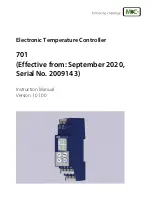
2-4 Examining operating status
Selection guidelines
2-11
1
2
3
4
5
6
7
8
9
10
11
Apx
Se
lec
tion gui
de
lin
es
= 25.0 [r/min]
(4)
Calculate the average rotational speed. Apply the values in (1), N = 100 r/min, and t = 0.8
seconds to the above formulas.
(5)
The figure on the right shows the points of operation determined by the effective torque and
average rotational speed calculated above, plotted on the graph of operable range of
FHA-11C-50, exceeding the continuous motion range. The conclusion is that this actuator
cannot be operated continuously under these conditions. Accordingly,
◆
the operation pattern
◆
load (possible reduction)
◆
actuator model No.
etc., must be reevaluated.
The following formula is a modified
version of the formula for effective torque.
By applying the value of allowable
continuous torque to T
m
in this formula,
the allowable cycle time can be
calculated.
Apply the following:
T
a
= 8.3 [N
・
m]
T
r
= 0 [N
・
m]
T
d
= 8.3 [N
・
m]
T
m
= 2.9 [N
・
m]
t
a
= 0.072 [s]
T
r
= 0.141 [s]
T
d
= 0.047 [s]
Then, the following equation is obtained:
t = (8.3
2
× 0.072 + 0
2
× 0.141 + 8.3
2
× 0.047) / 2.9
2
= 0.97 [s]
Based on the result, setting the cycle time to 1.0 seconds or more to provide a longer stop time
gives T
m
= 2.9 [N
・
m] or less, thereby permitting continuous operation within the
allowable
continuous
torque.
The aforementioned continuous motion range represents an allowable range where
the actuator installed on a specified aluminum radiation plate is operated under natural
air cooling. If the radiation area of the mounting member is small or heat conduction of
the material is poor, adjust the operating conditions to keep the rise in the actuator's
ambient temperature to 40 K or less as a guide.
Operable range of FHA-11C-50
Motion range during
acceleration and deceleration
Continuous
motion range
Aluminum radiation plate: 150
×
150
×
6 [mm]
2
m
d
2
d
r
2
r
a
2
a
T
t
T
t
T
t
T
t
×
+
×
+
×
=
0.8
0.047
2
100
0.141
100
0.072
2
100
N
av
×
+
×
+
×
=
50% duty range
















































